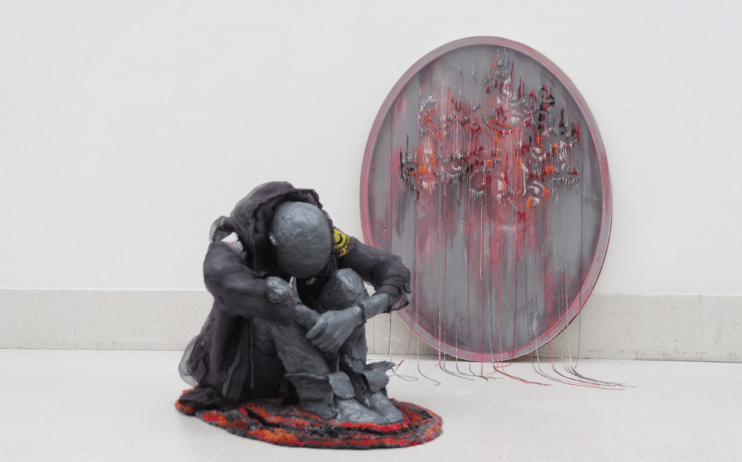Saatchi show forces us to look anew at homelessness

We are so used to looking away. Turning our heads, averting our gaze. Homelessness Reframed, a new exhibition at the Saatchi Gallery, makes this impossible.
As soon as you enter the one-room show, you are struck by a wall of framed photos showcasing signs made by people without a home from all over the world. These personal placards, which we tend to push out of minds, now demand our attention. Framed individually in rows across the entire left-hand wall, the absence of their makers is intense. “Bitte hilfen fur familien”, says one. “This is awkward 4 me too”, says another, with a grinning face drawn next to it. “I’m just hungry”, reads another.
What happened to the people who wrote these signs, in turns desperate, comedic or sad. You cannot help but note your own hypocrisy: next time you pass one, will you give it the same attention you are giving these signs now? It’s uncomfortable but presumably that’s the point. You can’t help but ask: do we have any right to gaze at these people’s real, earnest, desperate pleas as if they were brushstroke masterpieces by Monet? Does the frame humanise the artist, or is it only a symbol of our distance from the real people living without a home?
An exhibition in three parts, the first is curated by the chief executive of a private family foundation. The rest is made up of works by artists who have themselves experienced homelessness. One is Robi Walters, who I met standing by his work. He is a meditative and kind looking man, standing by a circular shaped explosion of colour. It’s a psychedelic meditation on waste and consumerism, he tells me, made up of intricate and multilayered spiral collages cut from multicoloured discarded material.
You can’t help but ask: do we have any right to gaze at these people’s lives as if they were brushstroke masterpieces
by Monet?
The next two parts are made up of exhibitions by people reflecting their own or others’ experiences of homelessness. The fact that most of the artists have personal experience with homelessness is (clearly) important: it gives them agency, and it complicates mistaken beliefs that homelessness is a semi-permanent state. In fact, it can happen to people at any stage in life; thousands of people are homeless yet work a job. A third of people wrongly assume that those who are homeless have been homeless before.
Rough sleeping or homelessness affects 300,000 people across the UK. Half are children. Not having a home doesn’t necessarily mean you are on the streets: you could be sofa surfing or living in other temporary accommodation. In London, the situation is particularly bad and getting worse. At the end of January, rough sleeping in the capital hit a 10-year high. In total, 4,389 people are now spending their nights on the capital’s streets – a 23 per cent increase on the same period in 2022.
It’s disturbing that we have to put ourselves through an ‘exercise of empathy’ – this implies the absence of empathy that necessitated it
Wendy Abrams, who coordinated the signs-in-frames artwork says: “The exhibition is intended to be an ‘exercise in empathy’, allowing visitors to see things they didn’t see before, or to see them through a different lens.” It is hard to read this without flinching: it’s disturbing that we have to put ourselves through an ‘exercise of empathy’ – this implies the absence of empathy that necessitated it. That the exhibition is held in Saatchi & Saatchi, located in one of London’s most affluent areas, also nags.
It was the work on the right hand side of the exhibition that pushed me to tears. An army of front doors stands glaring at the viewer. Each is decorated differently, with graffiti, photo frames and messages. Family photos with the eyes crossed out; the words “It is a double-edged sword”; newspaper stuck on repeatedly showing the word BROKEN. These menacing meditations on home were compiled by children living at various locations chosen by the charity Homewards – part of the Prince and Princess of Wales’s foundation. This final section is called Open Doors, and while it is meant to be hopeful, it is undeniably dark.
Homelessness Reframed is almost the wrong title. All too often homelessness exists out of the frame – this exhibition pulls it inside.